Trade marketing and traditional marketing are two main types, each with strengths and applications. Both aim to increase sales and brand awareness, but they operate differently.
Many companies find it hard to distinguish between these approaches, often resulting in misused resources and subpar outcomes. Common errors include:
- Overspending on traditional ads when partnerships with retailers might be more effective
- Concentrating on trade relationships and neglecting consumer engagement
- Not incorporating digital strategies in both trade and conventional marketing efforts
Take a consumer goods company as an example. It might invest in TV commercials when negotiating better shelf placement with stores, which could boost sales. , a B2B firm might focus on trade shows missing opportunities to build brand awareness through targeted online campaigns.
The digital revolution has made distinguishing between trade and old-school marketing harder. This opens up new doors but also brings fresh problems. We’ll look at these changes and help you pick the right plan for your company, considering how the marketing world is shifting.
Key Takeaways
- Trade marketing targets business partners, while traditional marketing aims at end consumers
- B2B strategies like account-based marketing are crucial in trade marketing
- Traditional marketing often has a broader reach but may be less targeted
- Both approaches can be integrated into a comprehensive marketing strategy
- ROI measurement differs significantly between trade and traditional marketing
- Digital transformation is reshaping both marketing types
Understanding these differences is critical to optimizing your marketing strategy and getting the best return on investment. Whether you’re a B2B company or a consumer brand, this knowledge will help you make smart decisions about your marketing approach.
Key Characteristics
Trade Marketing: Focusing on Business Partners
Trade marketing targets middlemen in the supply chain, such as retailers and distributors. Its main goal is to build stronger relationships with these partners and increase product visibility in stores. This approach often involves:
- Working with retailers on promotions
- Offering unique incentives to distributors
- Creating eye-catching displays in stores
For example, a beverage company might offer a store exclusive promotional materials and extra profit on a new product launch. This ensures the product gets prime shelf space and the retailer’s support.
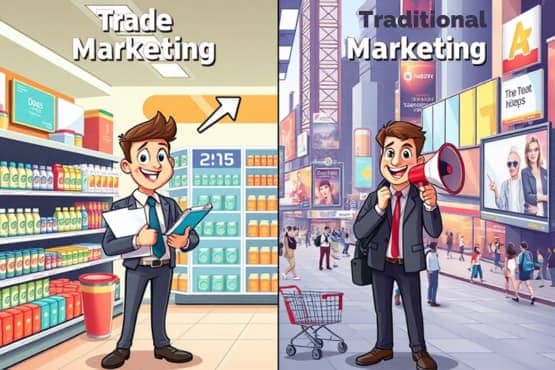
Traditional Marketing: Reaching the End Consumer
Traditional marketing casts a broader net, aiming to reach the final consumer directly. It often uses mass media channels to build brand awareness and customer loyalty. Common tactics include:
- TV and radio advertisements
- Billboard campaigns
- Social media marketing
A car manufacturer, for instance, might run a national TV campaign showing off their latest model’s features to attract potential buyers.
| Aspect | Trade Marketing | Traditional Marketing |
|---|---|---|
| Primary Target | Business partners | End consumers |
| Focus | Product placement, partner relationships | Brand awareness, customer loyalty |
| Channels | Trade shows, B2B platforms | Mass media, social media |
| Goals | Increase market share, improve distribution | Build brand image, drive consumer sales |
| Typical ROI Metrics | Sales volume, market share | Brand awareness, customer acquisition cost |
Target Audience Comparison
Understanding your audience is key in both approaches, but the focus differs significantly.
Trade Marketing Audience
In trade marketing, the audience consists of:
- Retail buyers
- Wholesalers
- Distributors
These professionals make buying decisions based on profit margins, fast product sales, and market trends. Their buying psychology is often more analytical and focused on business outcomes.
For instance, a retail buyer for a grocery chain might care more about a product’s sales speed and profit per square foot than how it appeals emotionally to consumers.
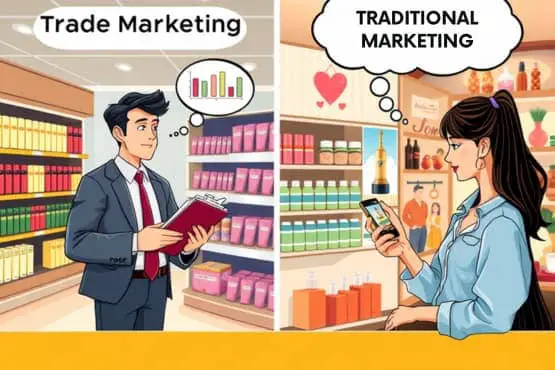
Traditional Marketing Audience
Traditional marketing targets a broader audience:
- Individual consumers
- Households
- Specific demographic groups
This approach often analyses consumer behaviour and trends to shape its strategies. Consumer psychology in this context is more driven by emotions and influenced by personal needs and desires.
A cosmetics brand, for example, might focus on creating an emotional connection with consumers by promoting self-confidence and beauty in their ad campaigns.
Marketing Channels Used
The channels used in each approach reflect their different target audiences and are changing with digital transformation.
Trade Marketing Channels
Trade marketing often uses specialized platforms:
- B2B e-commerce sites
- Trade publications
- Industry-specific events and trade shows
Digital transformation has introduced new channels like virtual trade shows and AI-powered B2B platforms. For example, a food manufacturer might use a digital trade marketing platform to showcase new products to retailers, complete with 3D product visualizations and real-time inventory data.

Traditional Marketing Channels
Traditional marketing uses a mix of established and new media:
- Television and radio
- Print media (newspapers, magazines)
- Digital platforms (websites, social media)
The rise of digital has led to more targeted and interactive traditional marketing channels. For instance, streaming services now offer highly targeted TV advertising, allowing brands to reach specific consumer groups with personalized messages.
Goals and Objectives
While both types of marketing aim to increase sales, their specific goals differ, impacting how businesses measure success and improve their strategies.
Trade Marketing Objectives
- Boost product visibility in stores
- Strengthen relationships with retail partners
- Increase market share within specific retail channels
Key Performance Indicators (KPIs) for trade marketing might include:
- Share of shelf space
- Number of retail locations carrying the product
- Sales volume through specific retail channels
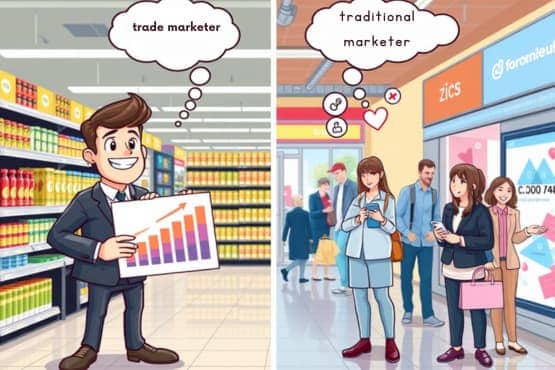
Traditional Marketing Objectives
- Enhance brand awareness among consumers
- Drive customer loyalty and repeat purchases
- Create emotional connections with the target audience
KPIs for traditional marketing often include:
- Brand recognition rates
- Customer lifetime value
- Social media engagement metrics
B2B Marketing Strategies
In the realm of trade marketing, B2B strategies play a crucial role. One efficient approach is account-based marketing (ABM).
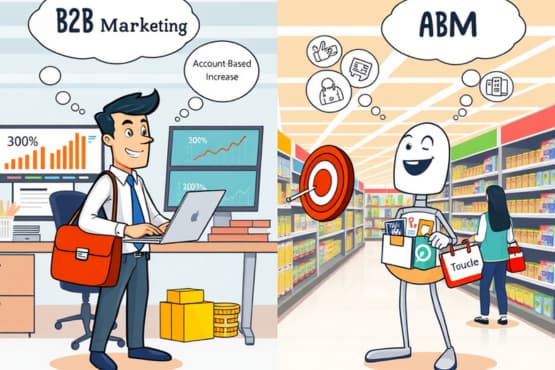
Account-Based Marketing in Action
ABM involves tailoring marketing efforts to specific high-value accounts, much like how trade marketing focuses on key retail partners.
This strategy has proven highly effective in B2B scenarios. For example, IBM implemented an ABM program that resulted in a 300% increase in revenue from targeted accounts within a year (Source: ITSMA).
Key elements of a successful ABM strategy in trade marketing include:
- Identifying key retail accounts or distributors
- Developing personalized content and promotions for each account
- Coordinating sales and marketing efforts to provide a unified experience
- Measuring results at the account level, including metrics like share of shelf and sales volume
Tools like LinkedIn Sales Navigator and Demandbase have made ABM more accessible to businesses of all sizes, allowing for precise targeting and personalization at scale.
For instance, a food manufacturer might use ABM techniques to create tailored promotional campaigns for specific grocery chains, considering each retailer’s unique customer base and store layouts.
Pros and Cons Analysis
Both trade and traditional marketing have strengths and weaknesses, which businesses must consider when crafting their marketing strategy.
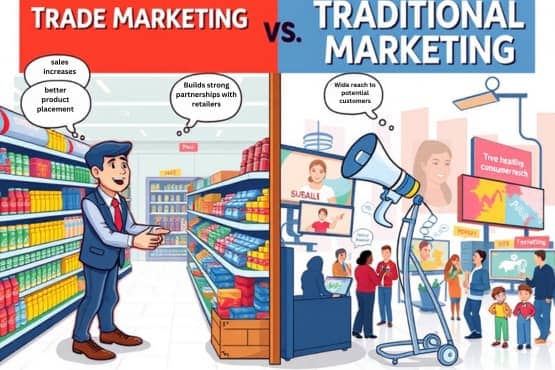
Let’s explore these along with potential ways to address the drawbacks.
Trade Marketing
Pros:
- Builds strong partnerships with retailers
- This can lead to better product placement
- Often results in immediate sales increases
Cons and Ways to Address Them:
- Limited reach to end consumers
- Solution: Work with retailers on joint consumer-facing campaigns
- Requires significant investment in partner relationships
- Solution: Use CRM systems to manage and track partner interactions efficiently
- Success depends heavily on intermediaries
- Solution: Diversify your distribution channels to reduce dependence on any single partner
- It can be challenging to scale quickly
- Solution: Use digital platforms to streamline partner onboarding and management
Traditional Marketing
Pros:
- Wide reach to potential customers
- Builds strong brand recognition
- Can create emotional connections with consumers
- Offers more control over brand messaging
Cons and Ways to Address Them:
- It can be costly, especially for mass media campaigns
- Solution: Use programmatic ad buying to reduce costs and improve targeting
- Maybe less targeted than trade marketing
- Solution: Implement data-driven segmentation strategies for more precise audience targeting
- ROI can be harder to measure precisely
- Solution: Use attribution modelling tools to track customer journeys across multiple touchpoints
- Effectiveness can diminish in cluttered media environments
- Solution: Focus on creating standout, memorable content and consider emerging channels with less competition
Real-World Examples
Let’s look at some successful applications of both marketing types, complete with data points to show their impact.
Trade Marketing Success: Coca-Cola
Coca-Cola has excelled in trade marketing by creating custom displays for retailers.

Their “Share a Coke” campaign included personalized bottle labels, which pleased retailers with increased sales and engaged end consumers directly.
The campaign resulted in a 2.5% increase in total sales volume and a 7% increase in consumption among young adults (Source: Coca-Cola).
Traditional Marketing Triumph: Apple
Apple’s “Get a Mac” campaign, which ran from 2006 to 2009, is a classic example of effective traditional marketing.
The TV ad series featuring personified Mac and PC characters significantly boosted Apple’s market share and brand image.
During the campaign, Apple’s market share in the US grew from 3% to 9%, and its brand value increased by 45% (Source: Forbes).
Hybrid Approach: Procter & Gamble
P&G successfully combines trade and traditional marketing. They work closely with retailers to optimize product placement while running large-scale consumer advertising campaigns.
This integrated approach has helped them maintain leadership in various product categories.
For instance, the Tide brand holds over 40% market share in the US laundry detergent market, demonstrating the power of combining strong retailer relationships with effective consumer marketing (Source: Statista).
Current Trends and Innovations
Both trade and traditional marketing are evolving with technology, creating new opportunities for businesses to engage their audiences.
AI in Trade Marketing
Artificial Intelligence is transforming trade marketing. For instance, Nestlé uses AI to analyze retail data and optimize their product mix and promotions for different stores.
This approach has led to a 5% increase in sales and a 3% reduction in out-of-stock incidents (Source: Nestlé).

Digital Transformation in Traditional Marketing
Traditional marketing is increasingly digital. Nike’s digital-first strategy, which includes personalized app experiences and social media campaigns, has helped them connect directly with consumers while supporting their retail partners.
This strategy has contributed to a 35% increase in digital sales and a 7% overall revenue growth (Source: Nike Annual Report).
ROI Comparison
Measuring return on investment (ROI) differs between trade and traditional marketing, reflecting their distinct goals and channels.

Trade Marketing ROI
Trade marketing ROI often focuses on:
- Sales volume increases
- Market share gains
- Improvements in retail partnerships
For example, a beverage company might measure the sales lift from a promotional display in a specific retail chain. Tools like Nielsen’s Retail Measurement Services can help track these metrics accurately.
Traditional Marketing ROI
Traditional marketing ROI typically considers:
- Brand awareness metrics
- Customer acquisition costs
- Lifetime customer value
A clothing brand might track how a TV ad campaign impacts website traffic and online sales. Marketing attribution tools like Google Analytics 4 can help businesses understand the customer journey across multiple touchpoints.
Future Outlook
The future of both marketing types is likely to be shaped by technology and changing consumer behaviours, leading to more integrated and data-driven approaches.

Emerging Technologies
Virtual and augmented reality are set to play more prominent roles in trade and traditional marketing, offering innovative ways to engage partners and consumers.
In trade marketing:
- Virtual showrooms allow manufacturers to showcase products to retailers without physical samples, reducing costs and time-to-market.
- AR-powered planograms help retailers visualize product placement, optimizing shelf space allocation.
In traditional marketing:
- VR experiences enable consumers to test products virtually before purchase, enhancing engagement and reducing returns.
- AR apps, like IKEA’s, allow consumers to visualize products in their own space, bridging the gap between digital and physical shopping experiences.
Early adopters in various industries are seeing success:
- Automotive: BMW uses AR to let customers visualize customized cars in real time, increasing conversion rates by 35% for specific models.
- Beauty: L’Oréal’s virtual try-on technology has led to a 30% increase in conversion rates for makeup products.
- Real Estate: Matterport’s 3D virtual tours have become standard in luxury real estate, reducing time-on-market by up to 31%.
Integration of Approaches
We’re likely to see more integration between trade and traditional marketing. Companies increasingly use data from both channels to create seamless marketing strategies that engage business partners and end consumers.
This integration will be driven by advanced analytics platforms that can process data from multiple sources to provide a holistic view of marketing performance.
For example, a consumer electronics brand might use insights from retail partner sales data (trade marketing) to inform their direct-to-consumer advertising campaigns (traditional marketing), ensuring consistent messaging and optimized product focus across all channels.
Conclusion
Trade marketing and traditional marketing each have their strong points and uses. Trade marketing shines when creating solid business relationships and getting the most out of sales channels. Conversely, traditional marketing still packs a punch for getting your brand known and keeping customers returning.
The companies that hit it out of the park often mix these two approaches. They shape their game plan based on their industry, what they’re selling, and who they’re trying to reach.
As tech keeps moving forward, both types of marketing will change with the times. This opens up new ways for businesses to connect with partners and customers.
You might lean more towards trade marketing if you run a B2B company. But if you’re selling straight to consumers, you might put more weight on traditional methods. Knowing how these two differ is key to developing a marketing plan that works.
Call-to-Action
Evaluate your current marketing mix. Are you leveraging the strengths of both trade and traditional marketing?
Consider how an integrated approach might benefit your business. Start by mapping out your sales funnel and identifying opportunities where each marketing type could have the most impact.
To optimize your strategy:
- Analyze your current ROI for both trade and traditional marketing efforts
- Identify gaps in your consumer journey where either approach could add value
- Explore new technologies that could enhance your marketing effectiveness
- Consider implementing an account-based marketing approach for high-value B2B relationships
By thoughtfully combining trade and traditional marketing strategies, you can create a comprehensive approach that drives results across your entire business ecosystem. Start implementing these insights today to stay ahead in the ever-evolving marketing landscape.




